
Milano Centrale is the main railway station of the city of Milan, Italy, and is the second busiest railway station in Italy for passenger flow and the largest railway station in Europe by volume.
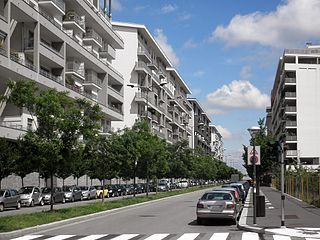
Milano Santa Giulia is a green and residential district ("quartiere") under construction in the south-east periphery of Milan, Italy, between the districts of Rogoredo and Taliedo, in the Zone 4 administrative division. As the construction is still in progress, the district is not formally recognized as such, and its area is still referred to as being part of Rogoredo and Taliedo.

Verona Porta Nuova is the main railway station of Verona, Italy. It is one of the two stations serving central Verona; the other station, Verona Porta Vescovo, is located at the east of the city.

Porta Nuova is one of the main business districts of Milan, Italy in terms of economy, and part of the Zone 2 administrative division. Named after the well-preserved Neoclassic gate built in 1810 on this site, it is now one of Italy's most high-tech and international districts, containing the country's tallest skyscraper: the Unicredit Tower.
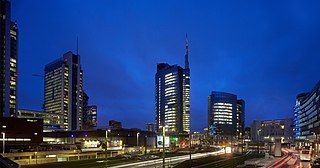
The Centro Direzionale di Milano is a business district (quartiere) in Milan, Italy, part of the Zone 9 administrative division. It is located north-west of the city centre, between the major railway stations of Milano Centrale and Milano Porta Garibaldi. The district developed in the second half of the 20th century; its realization was planned by the city administration to relieve congestion in the city centre by moving business and tertiary activities in the new area. Coherently with this plan, the district is mainly occupied by modern office buildings, including several of Milan's skyscrapers.
Covivio is a French property management company founded in 1998. Its activities are divided between the office property sector (54%), the residential sector (30%) and the hotel sector (16%).

Desenzano del Garda-Sirmione station is a railway station serving the town and comune of Desenzano del Garda, in the region of Lombardy, northern Italy. Opened in 1854, it forms part of the Milan–Venice railway.
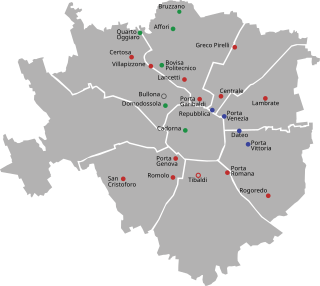
Milan has 24 railway stations in use today. Of these, 18 are managed by RFI, while the remaining 6 are operated by Ferrovienord. Three more stations are currently in the planning stage for the city area: Canottieri, Dergano and Zama.

Castello Cova, also known as Palazzo Viviani Cova is a landmark Neo-Gothic style residential and business building located on Via Giosuè Carducci #36, in central Milan, region of Lombardy, Italy. It is located some 100 meters west of the Basilica of Sant'Ambrogio. The building was designed by architect Adolfo Coppedè. Adolfo's career is also noted for designing the Casa del Fascio in Signa, and he was never shy to indulge in the appropriation of former styles and symbols; this building notable for its height and accumulation of Gothic architecture motifs such as a merlionated tower, peaked and rusticated ground-floor arches, and mullion-windows. It sports numerous decorated balconies on the facade.

The UniCredit Tower is an office skyscraper in Milan, Italy. At 231 metres (758 ft), it is the tallest building in Italy. The Allianz Tower, at 209 m (686 ft), is still the tallest building in Italy if ranked by highest usable floor. The building is the headquarters of UniCredit, Italy's largest bank by assets, and is part of a larger development of new residential and business structures in Milan's Porta Nuova district, near Porta Garibaldi railway station, located at Piazza Gae Aulenti.

Giuseppe Zanoia (1752–1817) was an Italian Neoclassical architect who is remembered for his Porta Nuova in Milan. He also collaborated on the Neogothic design of Milan's Duomo.
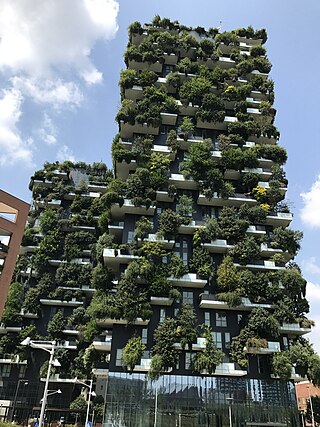
The Bosco Verticale is a complex of two residential skyscrapers designed by Boeri Studio and located in the Porta Nuova district of Milan, Italy. They have a height of 116 metres (381 ft) and 84 m (276 ft) and within the complex is an 11-storey office building.
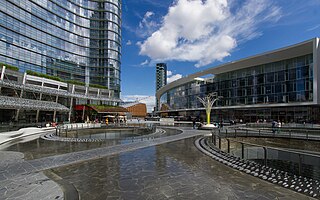
The Zone 9 of Milan, since 2016 officially Municipality 9 of Milan, is one of the 9 administrative divisions of Milan, Italy.
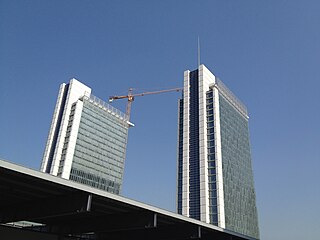
The Garibaldi Towers are two high-rise buildings in Milan. They are next to Porta Garibaldi railway station. They were built between 1984 and 1992 by the Italian state railways Ferrovie dello Stato to house its offices. The buildings are 100 meters tall with 25 floors.

Piero Portaluppi was an Italian architect. He is known for his prolific output, having designed over 100 buildings in Milan.

Rosarno railway station is a railway station of the Italian city of Rosarno, Calabria, part of the Battipaglia–Reggio di Calabria railway.
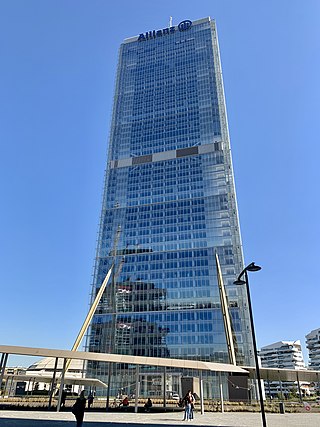
Allianz Tower, also known as Isozaki Tower, is a fifty-floor, 209-metre-tall (686 ft) skyscraper in Milan, Italy. Designed by Japanese architect Arata Isozaki and Italian architect Andrea Maffei, it serves as the headquarters of the Italian subsidiary Allianz SpA.

The building at Piazzale Cantore #10 first housed the Scuola Professionale Arnaldo Mussolini; it had been erected by the Fondazione Emilio di Magistris but is presently the offices of the Ente Morale Giacomo Feltrinelli per l'incremento dell'Istruzione Tecnica (EMIT). The building is an example of fascist architecture and decoration.

The Gioia 22 Tower is an office skyscraper in Milan, Italy. Built between 2018 and 2021, the tower stands at 121.4 m (398 ft) with 25 floors and is the current 9th tallest building in Milan.


















